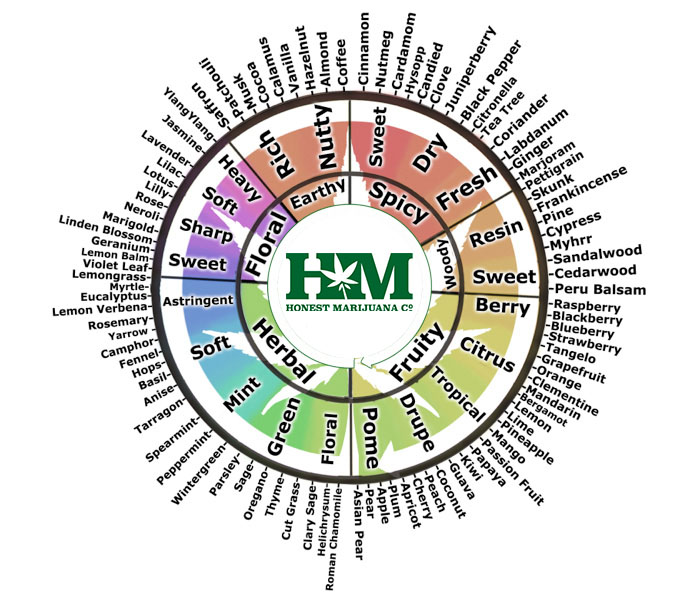
10 Oct This Ingredient Is What Makes Your Weed Smell and Taste Great
Terpenoids and terpene oils provide the aromas and flavors of countless plants. And, while everyone knows that the THC in pot is what gets you high, very little is known about terpenes. There are reportedly several positive medicinal effects from terpenes, however here we’ll be discussing mostly the flavors terpenes influence in your favorite strain for vaping. These companies are mastering the art of refining terpenes to make oils and extracts taste better and better!
In general terms, terpenes — both terpene oils and terpenoids — are strong smelling oils produced by a vast multitude of plants and some animals. They’re one of the most abundant and varied classes of organic molecules in the world. In fact, there are about 25,000 terpenoids alone. In some plants, cannabis included, the pungent odors of the terpene oils provide a protective mechanism that keeps herbivore animals away – sort of a built-in defense mechanism. This variety of terpenes are also responsible for the plethora of pot strains. However, many new oils used in vape pens are using chemicals to create exotic flavors, prompting new businesses to create a more purified method of creating vape oils.
Los Angeles Refinery was started as a small-scale grow operation to capitalize on the growing popularity of cannabis oils and extracts. Upon puffing on a vape pen many of these concentrate-filled cartridges had a harsh, artificial taste to them. They realized was that many oil manufacturers use chemicals or synthetic materials to fake the taste and aroma of the cannabis strains they’re named after. Ever wonder why Girl Scout Cookies weed tastes so much like, well … Girl Scout Cookies?
While terpenes are naturally occurring in cannabis plants, extracting and refining them for use in a concentrate or oil is a difficult process. More important, it’s an extremely expensive one, as the weed plant that it’s being extracted from is destroyed in the process. Cannabis terpenes on the market today can cost upward of $250 per milliliter, which is why they are relatively rare, in low supply and not often used by California manufacturers.
So small operations like Los Angeles Refinery began researching the process, experimenting with extraction, and through trial and error came up with a system that uses cold temperatures to keep the full terpene profile intact — high heat can destroy some terpene molecules, he says. Los Angeles Refinery now sources its organic cannabis from “strategic” partners and then uses a proprietary process to break the plant down into molecular parts, remove contaminants such as waxes and lipids, and then reassemble the desired ingredients of THC and terpenes into a final product.
Ryan at LA Refinery (not his real name) says, “If you vape on our product versus another company that puts in artificial flavor … you can tell,”… “We’re trying to capture that [flavor] profile that nature created … rather than create our own.”
While cannabis terpenes may work for a small-scale, boutique company like Los Angeles Refinery, which produces them in house, they can be hugely cost-prohibitive for larger manufacturers. That’s why most producers opt for food-based terpenes instead — a safer, better-tasting alternative to chemicals and much more affordable and readily available than cannabis, explains Drew Jones, founder and owner of Connoisseur Concentrates.
“What would be preferable would be if everyone extracted it [terpenes] from cannabis, but there’s just not enough of it,” he says.
A weed industry vet and one of the first to sell terpenes, Jones officially founded his Portland, Oregon–based company in 2014 and, earlier this year, opened the Terpene Lab in downtown L.A. Jones’ business now consists largely of selling terpenes wholesale to companies flavoring distillates or creating vape pen cartridges. At Jones’ store in L.A., cannabis business owners can come in to sample terpenes, mix and match flavors and create their own blends — cherry mixed with cheesecake mixed with gelato, he says as an example. The Terpene Lab itself mixes flavors including Skittles, Tangerine and Sour Diesel.
Connoisseur Concentrates uses organic terpenes sourced from non-cannabis plants — from lemons to pine trees — to re-create the cannabis aroma. After all, the Pinene found in cannabis is the same that’s found in a pine tree, says Jones.
“It’s all the same terpene,” he says.
Obtaining the right cannabis flavor isn’t as simple as pure extraction, however. For one, a high-quality blend that accurately re-creates a flavor could contain up to 20 different terpenes, Jones says. But some manufacturers will use just one.
Analyzing terpene profiles and discussing and experimenting with cannabis aromas is much more interesting than simply getting people high, Jagger says. While he does create cannabis-infused foods that contain the standard THC or CBD, he also makes his own terpene sugars and salts, which are more intended to capture the essence of the cannabis as opposed to the psychoactive effects. Jagger also makes his own terpene honey, by taking raw cannabis he grows himself, placing it in a jar, pouring honey over it and then storing it in a cold, dark place for three to six months.
The chef also builds entire dishes around cannabis strains. One example is the Blue Dream Salad, which includes terpenes of its namesake blueberry weed and plays off these flavors with dehydrated blueberries, pine nuts and aged Gouda cheese.
Overall, cannabis terpenes are simply a new, creative tool for creating flavor, Jagger says.
“I really think that just like there’s a place for fine wine, there’s a place for fine cannabis, and a lot of that is going to be terpene-rich cannabis,” he says.
Contributors: Laweekly.com


No Comments